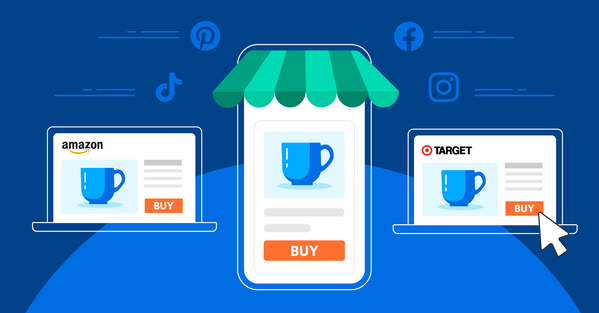
Chamberlain Coffee is candid about its desire to be a multichannel brand. Eager to offer its products wherever and however customers are shopping, the brand is scaling availability across channels, eager to appease the expectations of its fans and loyalists.
As CEO Christopher Gallant puts it, “Thinking about this omnichannel approach we now have, how do we attract new consumers and make our current consumers really happy in DTC? How do we interact with consumers on Amazon?”
In today’s competitive landscape, maintaining an effective brand presence across multiple channels is more important than ever, a fact Chamberlain Coffee sees clearly.
With customer expectations continuously evolving, technology advancing at a rapid pace, and an onslaught of ecommerce headwinds facing merchants, ignoring the importance of omnichannel will spell disaster for any brand looking to maintain relevance.
The ecommerce market is ripe with opportunity, surpassing $1 trillion in spend and projected to increase to nearly 25% of total retail by 2025. To successfully seize the moment and capture sales, however, brands must optimize their online and offline sales strategies, selling wherever their customer is shopping and providing a consistent customer experience across touchpoints.
This is the omnichannel imperative.
It’s Not All Equal When it Comes to Ecommerce
Brands that consider “ecommerce” a channel of its own are doomed to fail.
Consumers at large often use the term ecommerce to refer to anything bought or sold online, encompassing any and all ways of purchasing or selling those products digitally. In reality, ecommerce consists of many channels— direct to consumer (DTC) storefronts, online marketplaces (Amazon and others), retail sites, social commerce, and more.
For example, DTC is a form of ecommerce, but not all ecommerce is DTC. One of the biggest benefits of the DTC model is a brand’s ability to own and leverage the rich data and insights, including purchase/repurchase cycles, sales trends, and lifetime value, cultivated through a 1:1 relationship with the customer.
On the flip side, a brand selling on Amazon will have access to the platform’s tremendous reach, but will cede control of the customer relationship, giving up access to critical customer data they could use to inform marketing and other business processes.
Because there are so many nuances to each of these channels, thinking generically about ecommerce, or the logistics and fulfillment processes that power it, simply doesn’t make sense.
For brands to find true success and scale in today’s climate, they need to avoid putting artificial walls around these separate channels and think about how to best balance their digital availability, as well as how to provide a consistent purchasing experience for their customers across every channel.
After all, a customer doesn’t think differently about buying a product from Amazon or another online marketplace. They expect a positive experience no matter where or how they’ve placed an order, and it’s up to the brand to deliver.
The New Breed of Digital-First Brands
For years, buzzy brands like Warby Parker and Casper set the tone for the DTC ecommerce strategy: sell exclusively through their own websites and stores and raise the investment capital to grow fast. Their value proposition was that selling direct to consumers allowed them to offer lower prices because the retail markup (sometimes up to 50% at department stores) was eliminated.
And while that was true, relying exclusively on their own channels proved risky for DTC brands. As digital ad prices rise, the cost of customer acquisition has limited opportunities for scale. When the pandemic hit and consumer shopping habits shifted, many of these brands had little in savings reserves and were forced to make cuts. At the same time, early investors were looking to make a return, pushing companies to find new ways to drive scale and profitability.
As a result of these macro changes, a new path forward has emerged. Instead of relying solely on DTC, many brands are now “digital-first,” building a new playbook for success that draws on early DTC strategies while maintaining focus on growing sustainably and becoming profitable. Many are using retail partnerships to do it. Take Larroudé shoes, for example. The brand launched in 2020 and has actively pursued wholesale deals with department stores like Nordstrom and Saks Fifth Avenue.
Even storied DTC brands are starting to change their ways. Glossier, once the DTC darling of the beauty world, is now expanding into Sephora stores as they seek to reach more consumers and expand their market. The move is cited as part of their omnichannel strategy—a sign that many DTC brands are moving away from exclusively selling via their own ecommerce websites.
The Balanced Approach to Ecommerce
While it’s true that brands can see success by selling exclusively on one ecommerce channel—whether that’s through their own website or on an online marketplace like Amazon—relying on one single platform or channel puts a business at risk.
For example, selling on Amazon is essentially selling through brick and mortar by another name. Brands pay for the right to sell through the platform (a full 50% of each sale, in fact), and cannot access the critical data needed to grow a business. So while the sales might be there, the opportunity to take those existing customers and leverage them for growth is not.
The key to long-term ecommerce success is balancing the omnichannel portfolio, selling across channels and formats that, taken together, drive scale and profitability while providing customers with a consistently satisfying experience.
While that may sound complicated, it doesn’t have to be. As the ecommerce industry grows and strategies evolve, companies like Flowspace are staying ahead of the trends and providing brands with the tools they need to provide a stellar omnichannel experience.
How Flowspace Supports Omnichannel
Flowspace powers independent fulfillment, supporting brands as they achieve omnichannel scale and success from DTC to B2B and beyond. Flowspace’s best-in-class solutions bring every sales channel together into a single point of command, providing a centralized fulfillment partner that scales with brands.
When selling on multiple channels, having a clear view of inventory is key to any successful omnichannel order management strategy. Nothing can slow down an omnichannel growth strategy like independently tracking inventory for each channel and having to manually reconcile them.
Flowspace’s OmniFlow software provides next-generation visibility, inventory, and order management tools that empower merchants to improve the end customer experience by ensuring seamless order fulfillment and delivery, from any source, to any end customer. With centralized, real-time insights and analytics, brands can better forecast inventory and optimize fulfillment to meet customer expectations for an ideal delivery experience.
The omnichannel imperative is clear – the only way to find true scale and success in today’s environment is to offer a differentiated yet integrated sales strategy, backed by efficient, reliable logistics.
By partnering with Flowspace, omnichannel scalability is within reach. Get in touch today to find out how Flowspace can power your brand to omnichannel success.







